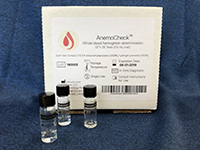AnemoCheck
Anemia Testing that is Home Based, Simple, and Affordable
Anemia, or low blood hemoglobin levels, affects two billion people every year, including 83 million in the United States. A powerhouse partnership between Emory University, Georgia Tech, Children's Healthcare of Atlanta, with the support of others, has developed a simple, cost-effective anemia test kit. It only uses a single drop of blood and produces easy-to-read results in under a minute.
AnemoCheck is the brainchild of Erika Tyburski, a graduate of Georgia Tech and current CEO of Sanguina, a biomedical start-up company out of Emory and Georgia Tech. AnemoCheck's development began as Tyburski's senior project in the Coulter Department of Biomedical Engineering. Wilbur Lam, MD, PhD (Emory, Georgia Tech, Children's) and Siobhan O'Connor, MD, MPH (Centers for Disease Control and Prevention) advised Tyburski on the project.

Erika Tyburski
"It was clear that health experts were concerned about the barrier to access for anemia testing, so we began brainstorming a solution to the problem," says Tyburski, who decided to pursue AnemoCheck full-time three weeks after graduating college. From the beginning, the project was centered around a "team ethic" that emphasized collaboration and communication.
Lam was impressed by Erika's initiative and the quick timeline of AnemoCheck's takeoff. "In a few short years, Erika and our lab have turned an undergraduate project into a commercialized product and Erika has transitioned from undergrad to CEO of our start-up company. Now she's my boss!"

Wilbur Lam, PhD
Tyburski has always been passionate about helping people, and her dedication to Sanguina is based in her personal experiences with the healthcare system. "In college, I went to a general practitioner for a mild illness, and they couldn't get me in for three weeks. I started hearing more and more stories about people with chronic medical conditions and seeing inefficiencies everywhere… There's a huge burden on the healthcare system that isn't sustainable. If we can empower people to take care of their own health in small ways, we can alleviate the system a little bit."
Before AnemoCheck, hemoglobin levels were typically measured from blood samples using hematology analyzers, which are housed in hospitals, clinics, or commercial laboratories and require skilled technicians to operate. Now, it's easy to test your own hemoglobin levels at home using a finger prick. "We specifically wanted something that did not require electricity or a reader of any kind," Tyburski says. "They are often complex and cost-prohibitive in user groups who need access the most."

AnemoCheck
This new test is a significant upgrade for people with chronic anemia, who need to monitor their hemoglobin levels more often. It also makes anemia testing more available to people in developing countries where access to a clinic or a trained medical technician is hard to come by. The new test is an accessible and cost-effective way to monitor your own health.
The science behind AnemoCheck is a simple oxidation-reduction chemical reaction that has been understood for decades. Tyburski and her team altered the reaction slightly to increase its long-term stability and to create an output that corresponded to a color. Hemoglobin levels from a single drop of blood catalyze a reaction between hydrogen peroxide and an agent called TMB, resulting in a color change that corresponds to the amount of hemoglobin in the blood.
The color, which can range from blue to bright red, can be compared to a standard color chart to get a general idea of a patient's hemoglobin level. For a more quantitative measurement, Sanguina has developed a smartphone app that will analyze your results for you. Research demonstrates that AnemoCheck is just as accurate as any hematology analyzer for detecting anemia.
This project was the work of a huge collaborative effort all based in the Atlanta area. The Georgia Research Alliance (GRA), an organization dedicated to expanding research capacity at universities and shaping startup companies in the state, is a supporter of AnemoCheck. GRA Vice President of Venture Development, Lee Herron, helped identify and support Sanguina. He asserts that "the GRA catalyzes the growth of start-ups based on university research. Sanguina is a great example of how GRA works. We have continued to support their development and refinement of the technology through milestone-based awards."
Lam says it was never a thought to move the company outside the city. "The Atlanta ecosystem is comprised of many organizations that can spur and accelerate the translation and commercialization of novel biomedical technologies. Starting with the engineering and technology capabilities at Georgia Tech to the clinical expertise at Emory, Children's, and the CDC, and coupled with supportive resources like Georgia Research Alliance, the culture and environment in Atlanta are extremely nurturing of young investigators and startup companies with a desire to venture into the health innovation space."
As for the future of Sanguina and AnemoCheck, Tyburski is both grateful and optimistic. "Personally, I have been able to see the idea from ideation as an undergraduate student, to bench testing, to clinical testing, to FDA review and clearance, to reaching market. I realize my team and I am very fortunate to be able to see our work actually reach patients. We're looking forward to a really bright future for the company."
Other collaborators and partners for the project include the Atlanta-based Centers for Disease Control and Prevention (CDC), a Coulter Translational Partnership Award, Georgia Centers for Innovation and Manufacturing, Atlantic Pediatric Device Consortium, The Foundation for Women and Girls with Blood Disorders, the National Science Foundation, and the National Institutes of Health.